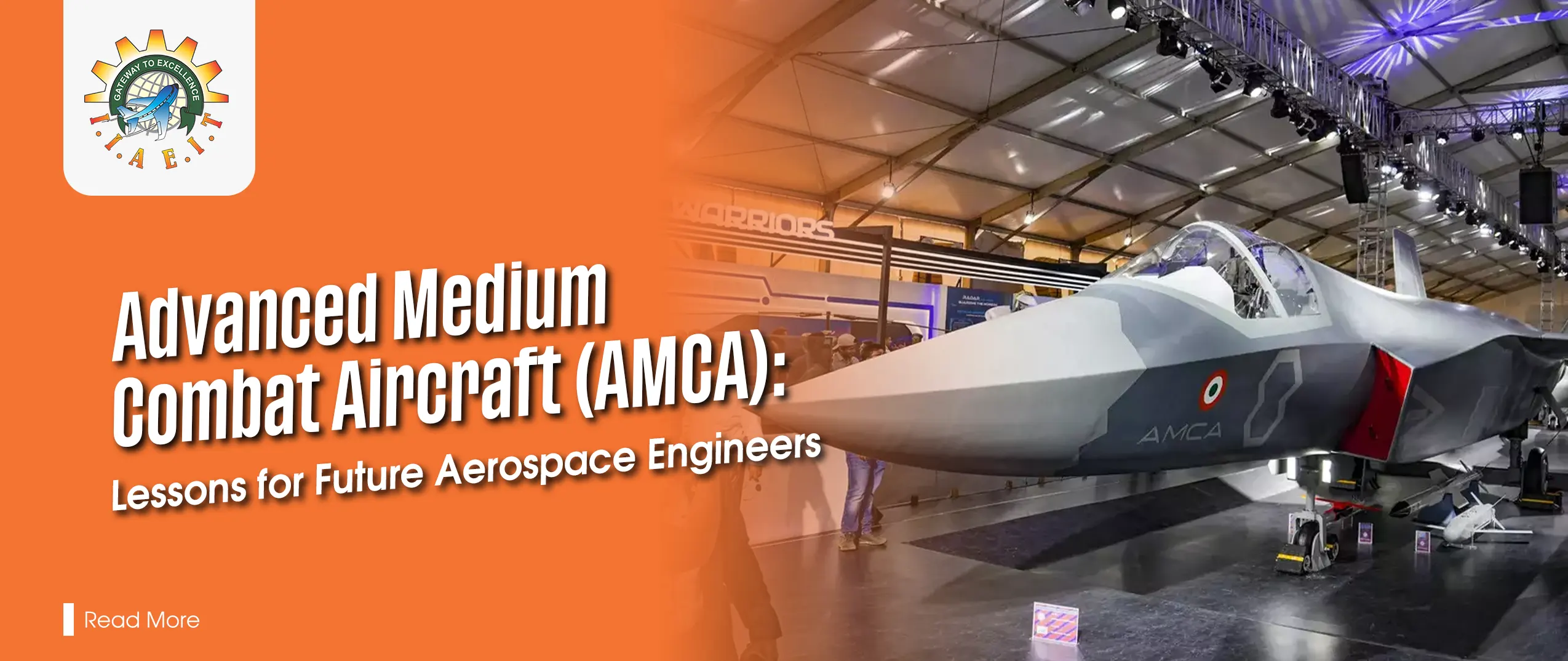Introduction – Why AMCA is More Than Just a Fighter Jet
The Advanced Medium Combat Aircraft (AMCA) is not just another headline in defence journals; it’s India’s bold step into the elite club of nations building fifth-generation stealth fighters. Designed to be fast, invisible to radar, and versatile in combat, the AMCA is more than a jet. It’s a symbol of self-reliance, engineering genius, and national pride.
For students dreaming of careers in aerospace, the AMCA is a masterclass in how textbook theory transforms into frontline technology. Every chapter of aerodynamics, propulsion, avionics, and materials science finds a living example in this aircraft. Beyond the military milestone, AMCA tells future aerospace engineers: “Your knowledge can literally take flight.”
Inside the AMCA Project
India’s AMCA program is supervised by the Aeronautical Development Agency (ADA) of DRDO in collaboration with Hindustan Aeronautics Limited (HAL). It is the nation’s most ambitious attempt yet at building a stealth-capable, multirole combat jet that can rival global leaders.
The roadmap looks like this:
- Prototypes: Multiple models are being prepared for intensive ground and wind tunnel testing.
- First Flight: Expected within this decade, setting the stage for serial validation.
- Production: Once cleared, the AMCA is expected to eventually operate alongside or succeed current fleets such as the Sukhoi Su-30MKI, MiG-29, and Mirage-2000.
But the project’s significance extends far beyond aircraft replacement. It aims to train an ecosystem of engineers, scientists, and technicians, anchoring India’s aerospace sector for decades. For young minds, this is a call to action: the country needs its brightest engineers to make AMCA fly.
AMCA’s Core Technologies & Their Link to Aerospace Education
Stealth Design & Aerodynamics
AMCA’s stealth features, from its angular frame to radar-absorbing coatings, are rooted in aerodynamics and fluid mechanics. What students calculate in drag equations and airflow models becomes the very science that hides a jet from enemy radars.
Propulsion Systems
High-performance engines capable of supercruise and manoeuvrability form the beating heart of the AMCA. The thermodynamics, turbo-machinery, and jet propulsion modules taught in aerospace courses are the same principles powering tomorrow’s fighter engines.
Avionics & Flight Control
From fly-by-wire systems to sensor fusion, avionics is the brain of the aircraft. AMCA integrates radar, infrared, electronic warfare, and communication suites into one seamless cockpit experience. This aligns directly with avionics engineering at IIAEIT, where students learn embedded systems, signal processing, and control theory.
Materials & Composites
The fighter’s stealth and agility depend on lightweight composites and advanced alloys. The labs where students test stress, fatigue, and resistance on materials are miniature versions of what’s applied in AMCA’s fuselage and wings.
How IIAEIT Prepares Students for Projects Like AMCA
With over 22 years of academic experience in cutting-edge education, IIAEIT Pune makes aerospace education more than just theory – it is practice-driven, mirroring the demands of projects like AMCA.
IIAEIT offers a blend of specialised programs with industry-driven learning. Its B.Tech and M.Tech in Aerospace Engineering cover everything from spacecraft design to advanced propulsion systems, while Avionics Engineering trains students in the electronic systems that power modern combat aircraft. The unique B.Tech + M.Tech Defence Technology program addresses missile technology, naval systems, and cybersecurity—skills vital for projects integrating next-generation defence capabilities.
Learning goes beyond classrooms, as students at IIAEIT explore:
- Labs & workshops equipped with CAD, CFD, Advanced CFD, Python for Aerospace, propulsion test rigs, and wind tunnels.
- Clubs such as Aeromodelling, Rocketry, and Avionics, where theory takes flight in prototypes.
- Industry tie-ups with aerospace and defence organisations, bridging education with live research.
By the time students graduate, they’re not just engineers on paper. They’re innovators capable of contributing to real defence projects, and AMCA is the perfect case study of what they can aspire to.
Career Pathways into Fighter Jet & Defence Aerospace Projects
AMCA also highlights career opportunities. Engineers can chart their paths into:
- DRDO, HAL, ISRO, and ADA – India’s core aerospace organisations.
- Private defence firms such as Tata Advanced Systems and L&T Defence.
- Global majors, including Boeing, Airbus, and Lockheed Martin.
Careers begin with internships or graduate engineer trainee programs, but growth comes through specialisation in areas such as aerodynamics, propulsion, avionics, or systems integration. The AMCA highlights one truth – modern aerospace careers demand multidisciplinary skills, combining mechanics, electronics, AI, and defence technology.
AMCA in India’s Defence Strategy & Future Prospects
The AMCA is central to India’s vision of Atmanirbhar Bharat (self-reliant India). By designing its own stealth fighter, India reduces dependence on imports, creates jobs, and builds intellectual capital.
There’s also a commercial dimension: export potential. Countries seeking cost-effective, fifth-generation solutions may look to AMCA once operational.
Role in Global Aerospace Competition
Globally, comparisons are inevitable. The F-22 Raptor set benchmarks in stealth and air superiority. The F-35 Lightning II is renowned for sensor fusion and multirole adaptability. Russia’s Su-57 offers agility and affordability. India’s AMCA aims to strike a balance – stealthy, versatile, and cost-effective – built by and for Indian engineers.
For students, these comparisons illustrate how design philosophies vary across nations, and why mastering fundamentals while innovating is crucial to shaping India’s future aerospace ambitions.
Conclusion – Turning Classroom Knowledge Into Real-World Impact
The AMCA story is not only about a jet; it’s about possibility. It shows students that aerodynamics equations, avionics coding, or materials lab tests are not abstract drills – they’re stepping stones to world-class innovations.
For aspiring engineers at IIAEIT Pune, AMCA proves that with the right skills, labs, and mentors, the classroom can connect directly to the skies. The next time a stealth jet takes off from an Indian runway, it could carry with it the knowledge, passion, and innovation of students who dared to dream.
FAQ’s
Q 1. What is AMCA?
A. The Advanced Medium Combat Aircraft (AMCA) is India’s indigenous fifth-generation, multi-role, stealth fighter jet being developed by the DRDO’s ADA and HAL.
Q 2. Who is making the AMCA fighter jet?
A. The AMCA is being developed by the Aeronautical Development Agency (ADA) of DRDO, in collaboration with Hindustan Aeronautics Limited (HAL).
Q 3. What makes AMCA unique compared to other jets?
A. Its stealth design, indigenous composite structure, advanced avionics, and multirole adaptability make it a benchmark project for India’s aerospace industry.
Q 4. When will AMCA be operational?
A. Prototypes are expected this decade, with production planned in the 2030s, making it India’s frontline fifth-generation fighter.
Q 5. How can aerospace students work on defence aircraft projects?
A. By pursuing aerospace or avionics engineering at institutes like IIAEIT Pune, gaining project experience, and interning with DRDO, HAL, or ISRO.


